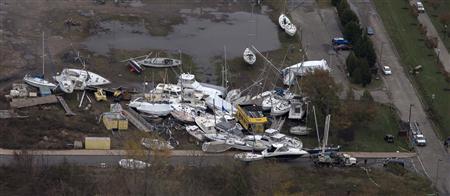
Floating robots to gather storm data, fuel cells for power outages, and tools to choose evacuation routes and help responders stay connected to the Internet are among the innovations that increasingly will help responders deal with future disasters, start-up companies say.
Floating robots to gather storm data, fuel cells for power outages, and tools to choose evacuation routes and help responders stay connected to the Internet are among the innovations that increasingly will help responders deal with future disasters, start-up companies say.
 |
| A view of boats from a marina which are washed ashore near Jersey City, New Jersey October 31, 2012. |
These tools are helping track weather patterns and measure their strength, soften their impact and speed recovery. Many are already proving their worth, not just in massive storm Sandy but in other weather disasters such as Hurricane Isaac and this summer's extreme drought in the U.S. Midwest.
VantagePoint-backed LiquidRobotics, for example, deploys floating robots to measure vast amounts of ocean data. Unlike passive buoys, its robots - called wave gliders - can be sent towards an oncoming storm. Unlike weather-tracking airplanes, the robots measure conditions at the ocean's surface, providing key information about a storm's future track and strength.
The wave gliders provide real-time information of tectonic plate movement, helping scientists determine if earthquakes will trigger tsunamis, for example. LiquidRobotics equipment is already deployed in some areas around the Pacific, including Indonesia and Japan, for this purpose.
Currently, LiquidRobotics works with some branches of the U.S. National Atmospheric and Oceanic Administration, including the agency's tsunami warning center and buoy center. But there is room for more government business, said Francois Leroy, senior vice president for science and international sales at the Sunnyvale, California-based company.
While he believes it is too early to approach officials in areas affected by Sandy to market the gliders, the company is planning its approach for a few weeks' time. "We are collecting the data, preparing the case in terms of what we have done, and can do," Leroy says.
Another data-intensive company that helps customers deal with weather conditions is San Francisco-based Climate Corp, backed by Index Ventures, Google Ventures and others. It uses myriad weather data points to price crop insurance.
INRIX, backed by August Capital and others, can measure highway traffic flow and help officials choose the best evacuation routes. Its clients include the I-95 Corridor Coalition, serving a major East Coast highway.
TRICK THE RESPONDERS' SOFTWARE
Fuel cells manufacturers provide power when electric power lines go down. These firms include Bloom Energy, backed by Kleiner Perkins Caufield & Byers and others; and ClearEdge, backed by private-equity firm Kohlberg Ventures and others.
ClearEdge, based in Hillsboro, Oregon, sells its fuel-cell system starting in 5-kilowatt units that can power a 3,000 square foot home; the units can also be stacked to provide more power. They work by forcing natural gas through a chemical system to generate power - without burning the gas.
Because natural gas often keep flowing through pipelines even during power outages, ClearEdge's systems could make a good choice for areas prone to electrical power failures, said Neal Starling, senior vice president for sales and marketing. Right now he is working on collecting information on how the natural gas grid held up during Sandy, to be used for sales pitches.
Seattle-based NetMotion Wireless helps officials respond to disaster by ensuring their networked software programs in key areas like dispatch and power-line location operate even as they move in and out of networks and wireless zones.
NetMotion's mobile virtual private-network technology works by effectively tricking disaster-responders' software into believing it is still connected to a network even when it is temporarily out of range, preventing it from crashing, losing data, and requiring reboots.
The company's customers include power provider Con Edison and state police in Connecticut and New York, according to Paul Riebock, who handles federal government relations for NetMotion, backed by Clearlake Capital.
He hopes that what he says was a strong track record during Hurricane Sandy will help win more customers, but does not plan on making any sales calls just yet. "You wait a little for things to settle down a bit," he said.
(Source: Reuters)




